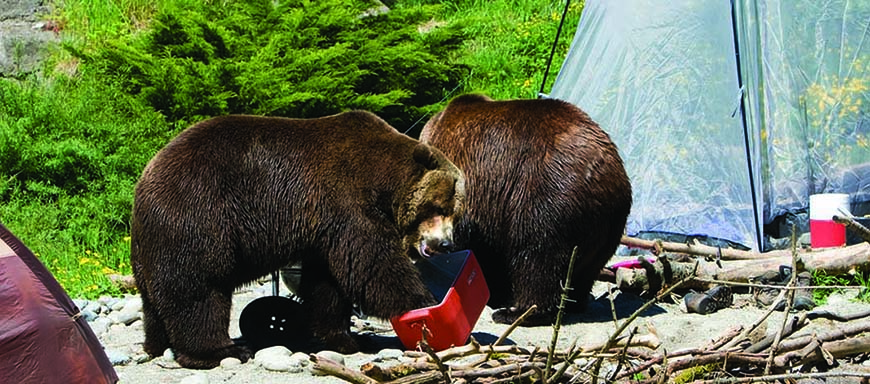Be Prepared – Be BearSmart
Being BearSmart is a particular concern from mid-July into the fall, bears can be found in different habitats in search of food. This includes digging for roots in shrubby or alpine habitats, eating insects in forests and bogs, and looking for berries in mixed and open forest habitats (Munro et al., 2006). Bears are therefore moving around a lot, and can be so preoccupied with finding food they don’t immediately notice people or can come into work sites, farms, communities, and homes—particularly if possible food sources are improperly stored or garbage is left out.
Cleaning up and storing food attractants properly in bear country will help minimize encounters.
If you do happen to encounter a bear, Bear Spray is a good thing to keep with and keep handy.
Bear Spray
What is bear spray? Bear spray normally contains three items: varying concentrations of capsaicin—the active chemical found in chili peppers— an oil base and propellant. A typical 225 gram can has 5-6 one second bursts, with a shelf life of up to 3 years.
How does it work? The effective range of bear spray is typically 3—5 meters. When the cloud of spray come into contact with the bear it causes irritation to the eyes, nose and mouth. The sound and sight of the spray coming out of the can may also help deter the bear. The immediate effect of spray is to deter the bear, whether it is approaching you or standing there.
Tips for Avoiding Bear Encounters at Home, Work and Recreating:
- Keep your BBQ clean—bears will smell food residues left behind and come investigate!
- Securely store pet food indoors or in bear-proof containers. Same goes for garbage, recycling, or dead livestock!
- Clean up fruiting trees and shrubs, and don’t put out bird seed.
- Have a safety plan for kids playing outdoors—they should know what to do if they see a bear! Practice a “bear safety drills.”
- Keep your dog on leash—dogs can trigger unwanted and negative encounters with bears.
- Remember: bears are curious, intelligent animals—once they learn about a new food source, even if left unintentionally, they will return to it. Keep a clean camp/work/yard site to help keep bears in the forest!
Checklists before you go
Everyone forgets things so to keep things simple here are some checklists you can download and print before you go out in the woods to help ensure you’re as best prepared as you can be.
- Home & Garden Bear Safety (PDF – 136KB)
- Outdoor Recreation & Back-Country Camping (PDF – 364KB)
- Mountain Biking (PDF – 180KB)

